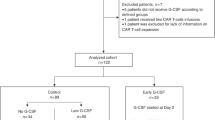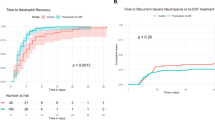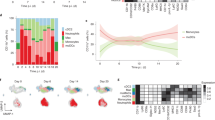Abstract
Chimaeric Lym-1 (chLym-1) is a monoclonal antibody generated by fusing the variable region genes of murine Lym-1 to human γ1 and κ constant regions. Owing to its selectivity and avidity for human malignant B cells, it is an attractive candidate for developing immune-interventions in B-lymphomas. In the attempt to identify rational bases for optimizing potential chLym-1 related therapeutic approaches, we studied the ability of this ch-mAb to trigger neutrophil-mediated Raji cell cytolysis in cooperation with two neutrophil-related cytokines, G-CSF and GM-CSF. ChLym-1 triggered low levels of cytolysis by normal neutrophils but induced consistent cytolysis in neutrophils from individuals treated with G-CSF. When exposed to GM-CSF, neutrophils from subjects treated with G-CSF became potent effectors, also leading to 75% lysis. By using mAbs specific for distinct FcγRs, normal neutrophils were inhibited by mAb IV.3, suggesting the intervention of FcγRII, constitutively expressed on the cells. On the other hand, neutrophils from patients treated with G-CSF were inhibited by mAb IV.3 plus mAb 197, a finding consistent with a cooperative intervention of FCγRII and G-CSF-induced FcγRI. The anti-FcγRIII mAb 3G8 promoted significant enhancement of the neutrophil cytolytic efficiency. Therefore, neutrophil FcγRIII behaves as a down-regulator of the cytolytic potential. The present findings suggest new attempts to develop mAb-based and G-CSF/GM-CSF combined immune-interventions in B lymphomas. © 2001 Cancer Research Campaign
Similar content being viewed by others
Article PDF
Change history
16 November 2011
This paper was modified 12 months after initial publication to switch to Creative Commons licence terms, as noted at publication
References
Biddle WC, Pancook J, Goldrosen M, Han T, Foon KA and Vaikus L (1990) Antibody-dependent, cell-mediated cytotoxicity by an anti-class II murine monoclonal antibody: effects of recombinant interleukin-2 on human effector cell lysis of human B-cell tumors. Cancer Res 50: 2991–2996
DeNardo GL, Lamborn KR, Goldstein DS, Kroger LA and DeNardo SJ (1997) Increased survival associated with radiolabeled Lym-1 therapy for non-Hodgkin lymphoma and chronic lymphocytic leukemia. Cancer 80: 2706–2711
Elsässer D, Valerius T, Repp R, Weiner GJ, Deo Y, Kalden JR, van de Winkel JGJ, Stevenson GT, Glennie MI and Gramatzki M (1996) HLA class II as potential target antigen on malignant B cells for therapy with bispecific antibodies in combination with granulocyte colony-stimulating factor. Blood 87: 3803–3812
Epstein AL, Mader RJ, Winter JN, Stathopoulos E, Chen FM, Parker JW and Taylor CR (1987) Two new monoclonal antibodies, Lym-1 and Lym-2, reactive with human B-lymphocytes and derived tumors, with immunodiagnostic and immunotherapeutic potential. Cancer Res 47: 830–840
Gavioli R, Spisani S, Giuliani AL, Cosulich E, Risso A and Traniello S (1991) CD16 and C3 receptors distinguish between the two mechanisms of tumour cytotoxicity in neutrophils. Br J Haematol 79: 170–176
Gessner JE, Heiken H, Tamm A and Schmidt RE (1998) The IgG Fc receptor family. Ann Hematol 76: 231–248
Graziano RF and Fanger MW (1990) FcγRI and FcγII on monocytes and granulocytes are cytotoxic trigger molecules for tumor cells. J Immunol 139: 3536–3541
Hu E, Epstein AL, Naeve Hu GS, Gill I, Martin S, Sherrod A, Nichols P, Chen D, Mazumder A and Levine AM (1989) A phase 1a clinical trial of Lym-1 monoclonal antibody serotherapy in patients with refractory B cell malignancies. Hemat Oncol 7: 155–166
Hu P, Glasky MS, Yun A, Alauddin MM, Hornick JL, Khawli LA and Epstein AL (1995) A human-mouse chimeric Lym-1 monoclonal antibody with specificity for human lymphomas expressed in a baculovirus system. Hum Antibod Hibridoma 6: 57–67
Huizinga TWJ, de Hass M, Kleijer M, Nuijens JH, Roos D and van der Borne AEG (1990) Soluble Fcγ receptor III in human plasma originates from release by neutrophils. J Clin Invest 86: 416–423
Kerst JM, Haas M, Van der Schoot E, Slaper-Cortenback ICM, Kleijer M, Vonder Borne AEG and Van Oers RHJ (1993) Recombinant granulocyte colony-stimulating factor administration to healthy volunteer: induction of immunophenotypically and functionally altered neutrophils via an effect on myeloid progenitor cells. Blood 82: 3255–3272
Kushner BH and Cheung NKV (1989) GM-CSF enhances 3F8 monoclonal antibody-dependent cellular cytotoxicity against human melanoma and neuroblastoma. Blood 73: 1936–1941
Kushner BH and Cheung NKV (1992) Absolute requirement of CD11/CD18 adhesion molecules, FcRII, and the phosphatidylinositol-linked FcRIII for monoclonal antibody-mediated neutrophil antihuman tumor cytotoxicity. Blood 79: 1484–1490
Michon IM, Gey A, Moutel S, Tartour E, Meresse V, Fridman W and Teillaud JL (1998) In vivo induction of functional FcγRI (CD64) on neutrophils and modulation of blood cytokine mRNA levels in cancer patients treated with G-CSF (rmetHuG-CSF). Br J Haematol 100: 550–556
Ottonello L, Morone P, Dapino P and Dallegri F (1996) Monoclonal Lym-1 antibody-dependent lysis of B-lymphoblastoid targets by human complement and cytokine-exposed mononuclear and neutrophilic polymorphonuclear leukocytes. Blood 87: 5171–5178
Ottonello L, Epstein AL, Dapino P, Barbera P, Morone P and Dallegri F (1999) Monoclonal Lym-1 antibody-dependent cytolysis by neutrophils exposed to granulocyte-macrophage colony-stimulating factor: intervention of FcγRII (CD32), CCD11b-CD18 integrins and CD66b glycoproteins. Blood 93: 3501–3511
Porter JC and Hogg N (1998) Integrins take partners: cross-talk between integrins and other membrane receptors. Trends Cell Biol 8: 390–396
Repp R, Valerius T, Sendler A, Gramatzki M, Iro A, Kalden JR and Platzer E (1991) Neutophils express the high affinity receptor for IgG (FcγRI, CD64) after in vivo application of recombinant human granulocyte colony-stimulating factor. Blood 78: 885–889
Rose ML, Gunasekera AH, DeNardo SJ, DeNardo GL and Meares CF (1996) Lymphoma-selective antibody Lym-1 recognizes a discontinous epitope on the light chain of HLA-DR10. Cancer Immunol Immunother 43: 26–30
Todd, III RF and Petty HR (1997) β2(CD11/CD18) integrins can serve as signaling partners for other leukocyte receptors. J Lab Clin Med 129: 492–498
Unkeless JC (1989) Function and heterogeneity of human Fc receptors for immunoglobulin G. J Clin Invest 83: 355–361
Vaickus L, Biddle W, Cemerlic D and Foon K (1990) A. Interferon gamma augments Lym-1-dependent, granulocyte-mediated tumor cell lysis. Blood 75: 2408–2416
Valerius T, Repp R, de Witt TPM, Berthold S, Platzer E, Kalden J, Gramatzki M and van de Winkel JGJ (1993) Involvement of the high-affinity receptor for IgG (FcγRI, CD64) in enhanced tumor cell cytotoxicity of neutrophils during granulocyte colony-stimulating factor therapy. Blood 82: 931–939
Valerius T, Elsässer D, Repp R, van de Winkel JGJ, Gramatzki M and Glennie M (1997) HLA class II antibodies recruit G-CSF activated neutrophils for treatment for B cell malignancy. Leukemia Lymphoma 26: 261–269
Würflein D, Dechant M, Stockmeyer B, Tutt AL, Hu P, Repp R, Kalden JR, van de Wikel JGJ, Epstein AL, Valerius T, Glennie M and Gramatzki M (1998) Evaluating antibodies for their capacity to induce cell-mediated lysis of malignant B cells. Cancer Res 58: 3051–3058
Zhou M and Brown EJ (1994) CR3 (Mac-1, αMβ2, CD11b/CD18) and FcγRII cooperate in generation of a neutrophil respiratory burst: requirement for FcγRII and tyrosine phosphorylation. J Cell Biol 125: 1407–1416
Author information
Authors and Affiliations
Rights and permissions
From twelve months after its original publication, this work is licensed under the Creative Commons Attribution-NonCommercial-Share Alike 3.0 Unported License. To view a copy of this license, visit http://creativecommons.org/licenses/by-nc-sa/3.0/
About this article
Cite this article
Ottonello, L., Epstein, A., Mancini, M. et al. Chimaeric Lym-1 monoclonal antibody-mediated cytolysis by neutrophils from G-CSF-treated patients: stimulation by GM-CSF and role of Fcγ -receptors. Br J Cancer 85, 463–469 (2001). https://doi.org/10.1054/bjoc.2001.1940
Received:
Revised:
Accepted:
Published:
Issue date:
DOI: https://doi.org/10.1054/bjoc.2001.1940
Keywords
This article is cited by
-
Protumor and antitumor functions of neutrophil granulocytes
Seminars in Immunopathology (2013)



